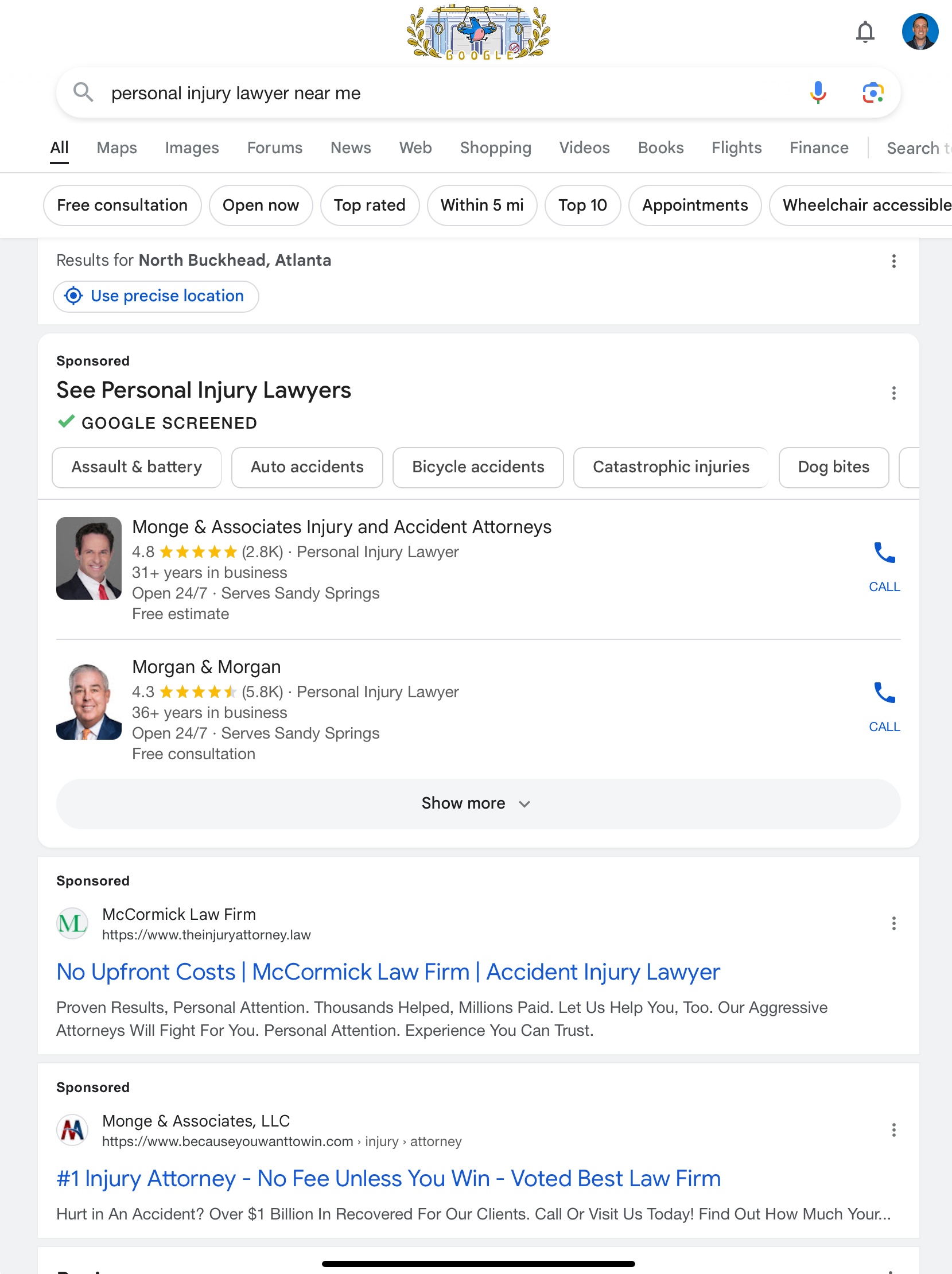Google Ads For Law Firms
PPC for Lawyers
Local Services Ads for Attorneys
Hint: They work best together
First, Why Run Pay-Per-Click/ Search Ads? Search INTENT
Understanding Search Intent
Search intent helps us understand the level of readiness behind a user’s search query. Understanding this intent is critical to showing the right ad at the right time but also at the right cost, because not each intent has the same value. For example, information intent below has always been better served through more of a broadcast strategy (shotgun approach) versus targeting commercial search intent (sniper rifle).
- Informational Intent: Users seeking information. For example, “Steps In the divorce process?” We can try and use the smart campaigns and more discovery-style campaigns for these if desired and apart of an active SEO strategy.
- Navigational Intent: a person looking for a specific website or page. example: “The XYZ Law P.C.” The Law Firm’s Google Business Profile (GBP) is essential here. Along with directions, social media sites, etc. anywhere people can find a profile about businesses online, you should be there.
- Transactional Intent: Users ready to make a purchase or hire a service. For example, “Hire a bankruptcy lawyer near me.” This along with the commercial investigation are where cases can either find you or find your competitors.
- Commercial Investigation: Users comparing options before making a decision. Example, “Best employment lawyer in Atlanta”. We create compelling ads and content to showcase why your firm is the best choice.

Show Up Where People Search
Five years ago, Google would have been the primary choice for advertising, but that’s not the case today. Just as you would advertise in the phonebook 20 years ago to have your number stand out, today’s marketing strategy involves a mix of places and types of interactions. Billboards, TV, radio, display, and video ads all contribute to brand building. This ensures that when people need the services you provide, they recognize and choose your brand anywhere they do their search; Google, Bing, DuckDuckGo, Ecosia, Brave, etc.
Pay-Per-Click (PPC) Strategy
PPC advertising ensures you show up when someone is searching for the services you provide. Our unique approach sets us apart because we recognize the platforms’ goals to maximize their revenue. Conversely, our goal is to maximize your return on investment. Google’s constant changes to their advertising platform are driven by profit motives, but we stay ahead by anticipating these changes, strategizing around new rules, restrictions, and auction dynamics, and uncovering hidden data in reporting.

Google Ads Strategic Campaign Setup
With over twenty-fives years of combined experience in Google Ads, we pride ourselves on not being a Google Partner or a Premier Partner. We advise businesses to be wary of Premier Partners, as their goal often seems to be maximizing your ad spend rather than your returns. Our experience shows that Google’s recommendations have not been in advertisers’ best interests for over a decade.

Local Services Ads by Google
Local Services Ads (LSAs) are another aspect of Google’s advertising offerings, primarily driven by regulatory compliance rather than performance. LSAs are highly user-signal dependent, making them unpredictable. However, it’s essential to set up a profile for your practice area, especially if you are an Employment Lawyer, Bankruptcy Attorney, IP Lawyer, or Family Law Attorney. While LSAs generally perform poorly for Personal Injury Lawyers, setting up your profile now ensures you are prepared for future changes.
Frequently Asked Questions
Question: How Much Should I Spend On Ads?
Answer: This is a multifaceted question. It should be based upon your rough total marketing spend for the year, broken out monthly. If you have high revenue growth goals for the firm over the next year, your total marketing to gross revenue should be roughly between 8-20%. NOW that does not mean you should spend, just to spend. Depending upon the amount, but it should be a healthy combination of organic marketing, broadcast advertising and paid search ads. Paid search ads would be one of the areas to try and max first, as any advertising the firm runs will benefit from showing the law firms ad at the top of the search results page when someone sees your ad and looks up the business.
Question: Do You Build Landing Pages For The Ad Campaigns?
Answer: We can build landing pages if needed, at an additional one-time cost per page. We highly recommend these are independent pages on your current website optimized for the user conversion path. For some research terms and campaigns we may run directly to the core pages of your website.
Question: How Can I Evaluate My Current Google Ads / Advertising Spend?
Answer: Follow our S.M.A.R.T. campaign spend strategy outline:
Specific (S)
Define clear objectives:
• Increase ROAS by X%.
• Reduce CPC by X%.
• Achieve a CTR of X%.
Measurable (M)
Identify key metrics:
• Click-Through Rate (CTR)
• Cost Per Click (CPC)
• Conversion Rate (CR)
• Return on Ad Spend (ROAS)
• Set benchmarks:
• Compare with industry standards.
• Use historical data for baseline comparisons.
Achievable (A)
Utilize Google Ads data for insights.
• Implement A/B testing for ads.
• Optimize landing pages for better conversions.
Relevant (R)
Align with business goals:
• Ensure ad campaigns support overall marketing strategy.
• Focus on high-performing keywords and result paths.
Leverage experience:
• Apply past learnings to current campaigns.
Time-bound (T)
Set timelines for goals:
• Short-term: Weekly performance reviews.
• Long-term: Quarterly assessments.
Regular monitoring:
• Daily checks for anomalies.
• Monthly deep dives for trend analysis.
Detecting Fraud and Inefficiencies
Monitor for unusual patterns:
• Sudden spikes in CTR or CPC.
• High bounce rates despite high CTR.
• Google Ads scripts for automated alerts.
• Third-party fraud detection software*.
Analyze traffic sources:
• Investigate sources with low conversion rates.
• Compare IP addresses and geographical data for anomalies.
*not recommended until full analysis.
Running your own google ads account? Checkout an essential script that will make your team’s job so much easier to track account spending per campaign. We are adding more. We made publically available, our Google ads script customizing ChatGPT. This is essential for all accounts but especially the high cpc, high competition personal injury, mas tort, workers comp and family law pay-per-click campaigns.
